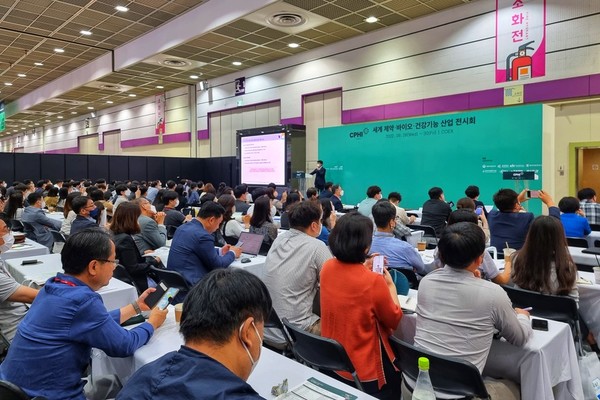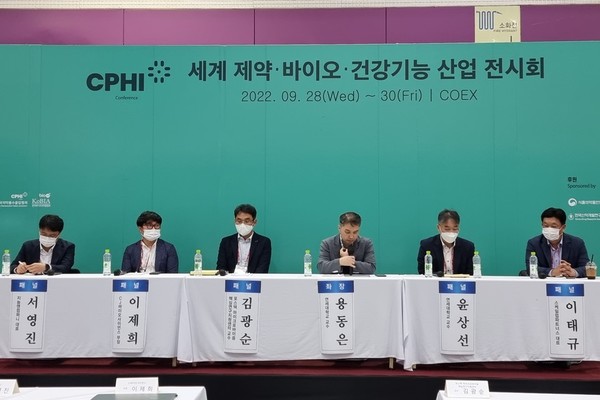Korean companies are rapidly joining the race to develop microbiome-based live biotherapeutic products (LBPs).
Industry officials and academics recently gathered in Seoul to discuss how to boost technological strengths and continue research and development in this promising market.
At COEX on Thursday, Convention on Pharmaceutical Ingredients (CPHI) and Korea Biomedicine Industry Association (KoBIA) held the Live Biotherapeutic Product Conference Session as part of CPHI Korea 2022.

In the first session, Park Keun-joon, senior manager of business development at Thermo Fisher Scientific Korea spoke on the trends of microbiome research, and Genome & Company CEO Seo Young-jin explained the company’s R&D of microbiome therapies. Then, Lee Je-hee, an official at CJ Bioscience presented technical challenges to developing new microbiome treatments, and Professor Kim Kwang-soon at POSTECH’s Life Science Department spoke on a microbiome R&D strategy using germ-free animals.
In the second session, Korean industry experts and scholars had a debate on strategies for microbiome technology development, regulatory agencies’ improvement of regulations, and ways to attract microbiome companies. The panelists’ discussion was floored by Professor Yong Dong-eun of laboratory medicine at Yonsei University Severance Hospital.

Yoon Sang-sun, CEO of Bio-Me, a microbiome therapy developer for rare and intractable diseases, said LBP development required regulators’ cooperation because the industry was in its infancy.
“Most substances of LBPs are microorganisms that co-exist in our body, so there are fewer safety concerns. The regulator should reflect this,” Yoon said.
CEO Seo of Genome & Company, which is conducting a clinical trial of microbiome therapy with MSD, said, unlike previous concerns, the U.S. FDA or Korea’s Ministry of Food and Drug Safety did not strictly require a mechanism of action (MOA) when approving a clinical trial for a new investigational drug.
“This is probably because microbiome therapeutic candidates’ safety is guaranteed to a certain point,” Seo said. “Both regulatory agencies looked at whether microorganisms could be stably cultured, for example, whether there was any genomic change during subculture, just like antibody drugs. In particular, I felt that the MFDS was open to new modalities.”
However, Lee from CJ Bioscience emphasized that a drugmaker should establish MOA during development, even if it could delay entry into a trial.
Lee said the discovery of MOA was the most difficult part of developing microbiome treatments.
Accurately knowing MOA is important because it would let the company know why it failed in a trial and continue to work on a second or third pipeline, he said.
“Rather than leading in a speed race, it would be better to prepare well and take steps one by one,” he said.
Scale Up Partners CEO Lee Tae-gyu said biotech companies will have to prove that microbiome therapies are superior to other new drug development platforms such as dual antibodies, antibody-drug conjugates (ADCs), or exosomes.
“From an investor’s perspective, the microbiome treatment market has high growth potential. Many firms such as CJ Bioscience, Genome & Company, KoBioLabs, and GI Biome have joined the market,” Lee said.
However, they will have to prove their market competence, he noted.
He went on to say that microbiome developers have yet to show any visible results, while ADCs or dual antibodies have reached commercialization.
“Although Seres Therapeutics in the U.S. recently succeeded the phase 3 clinical trial of an investigational microbiome therapeutic in clostridium difficile infection, it did not receive a favorable reaction from the market,” Lee said.
“This is maybe because expectations have been already reflected in the market and partly because the investment sentiment went jittery over the biotech industry.”
Despite all these factors, the potential of the microbiome sector remains great because it is linked with the health/functional food and bio platform markets, he added.
Related articles
- Genome & Co.’s US subsidiary breaks ground for microbiome manufacturing plant
- Genome & Co. to work with MSD for combo drug of GEN-001, Keytruda
- Liveome wins patent for microbiome therapy development platform in Japan
- CJ Bioscience struggles to make profit
- GI Biome OKed to test microbiome candidate in colorectal cancer
- Celltrion, LISCure Biosciences to co-develop microbiome-based Parkinson's disease treatment

